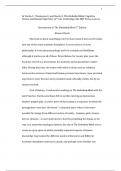Exam (elaborations)
Introduction to The Embodied Mind 2nd Edition Eleanor Rosch
- Course
- Institution
Introduction to The Embodied Mind 2nd Edition Eleanor Rosch Introduction to The Embodied Mind 2nd Edition Eleanor Rosch much that Buddhism and contemplative practices in other traditions could contribute to science, not to mention human life (some might say the heart of what they have to contri...
[Show more]



